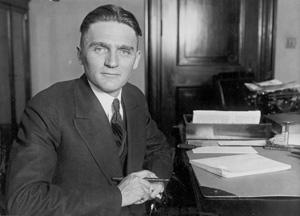 |
Senator Gerald Nye, whose 1934-1936 hearings into the role the munitions industry played in the US entrance into World War I helped pave the way for the passage of the 1935 Neutrality Act. The measure symbolized 1930s isolationism. |
February 19
Isolationism
 |
Senator Gerald Nye, whose 1934-1936 hearings into the role the munitions industry played in the US entrance into World War I helped pave the way for the passage of the 1935 Neutrality Act. The measure symbolized 1930s isolationism. |
| Historians have long debated the causes and intensity of 1930s isolationism. The reading we focus on for today--Daniel Rodgers' chapter on the New Deal--challenges conventional wisdom in arguing that an intellectual internationalism persisted throughout the 1930s. For documents, though, we'll be looking at the more traditional debate over neutrality policy. |
READING:
DOCUMENTS:
|
 |
||||||

Two views of the changed European boundaries after the Munich agreement. Click on each map for an enlarged version. |